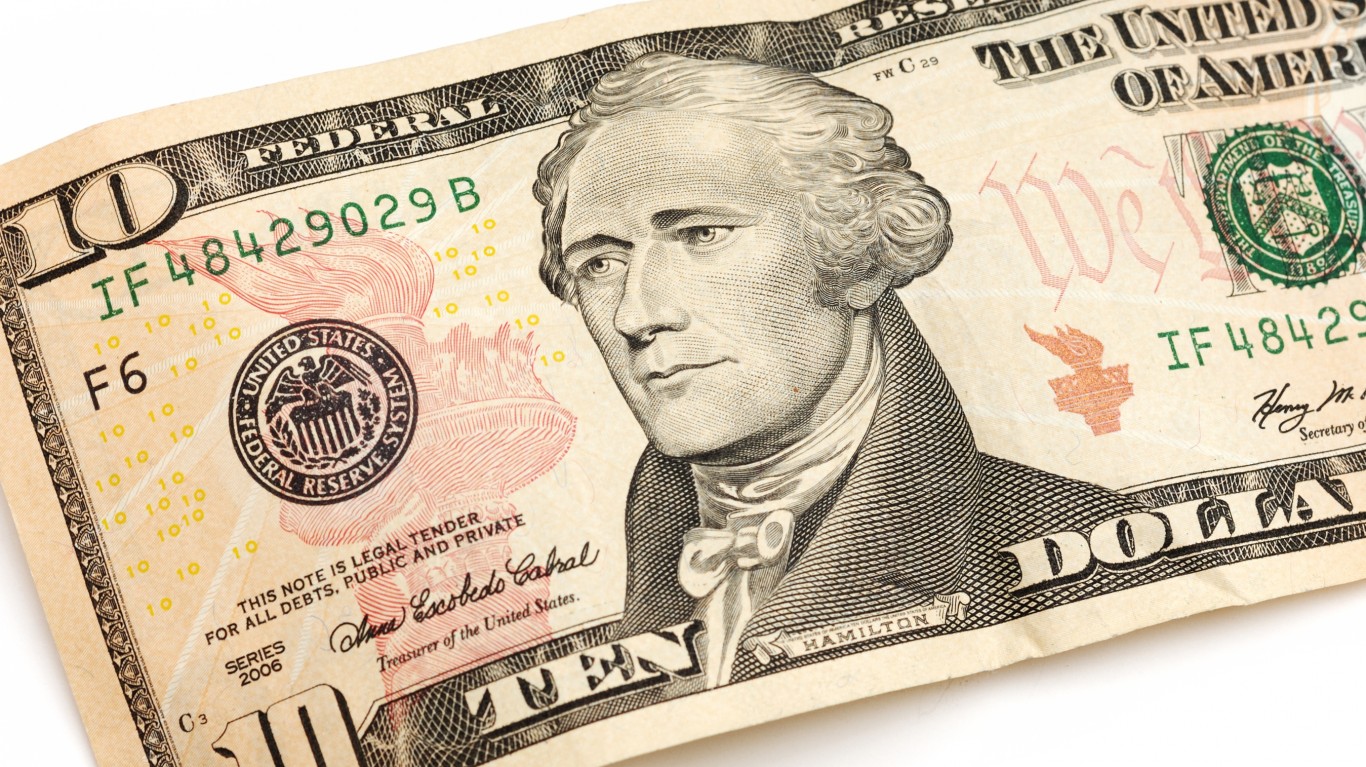 The illicit trade in humans, drugs, organs, and nine other huge international criminal activities produces $650 billion in revenue per year. 24/7 Wall St. gathered data from from a Global Financial Integrity report entitled “Transnational Crime in the Developing World.” The report provided information from the UN, the International Labor Organization,the Organization for Economic Cooperation and Development, and the Center for Defense Information, and was used to identify the twelve largest international criminal activities in the world.
The illicit trade in humans, drugs, organs, and nine other huge international criminal activities produces $650 billion in revenue per year. 24/7 Wall St. gathered data from from a Global Financial Integrity report entitled “Transnational Crime in the Developing World.” The report provided information from the UN, the International Labor Organization,the Organization for Economic Cooperation and Development, and the Center for Defense Information, and was used to identify the twelve largest international criminal activities in the world.
There are no victimless crimes, this data shows. Extensive deforestation of the Amazon region allows sale of lumber without tax or tariffs and continues to damage the world’s ecosystem. Organs which are harvested overseas and shipped to the US are sold to people who might have to wait months or years for them. The people at the top of lists to get transplants almost never have access to these body parts. Art stolen from the excavation of ancient ruins prevents archaeologists from adding to our knowledge of distant civilizations. These artifacts are also lost to universities and museums where they could become part of valuable exhibits.
The most profound financial impact of the $650 billion each year in international crime is that it deprives nations of tax receipts. This affects small, developing countries which have mines and valuable wildlife as their primary resources. These countries, and the people who live there, receive nothing from the goods which are illegally harvested within their borders. In many cases, the impoverished citizens of a country are paid next to nothing, while the middlemen – the international gangs and cartels – reap billions in profits.
International crime is primarily perpetrated by individuals who either live in developed nations or already have fortunes in the underdeveloped world. Humans trafficking usually begins in a country like Nigeria or Vietnam, and these “stolen” people are most often sent to wealthy countries like the US, Saudi Arabia, and Japan. Drugs which are grown in South America and Afghanistan earn little profit for the farmers in these nations. Middle men make most of the money as they package and ship drugs. Local dealers make modest amounts at best. The reward matches the risk in the drug trade. Criminals who traffic in tons makes more than the dealers who sells ounces.
In its work to properly explain the Twelve Most Profitable International Crimes, 24/7 Wall St. analyzed source material that provided the estimated value of the market for each criminal enterprise, the directionality of the flow (the countries of origin and destination), the amount and type of illegal contraband or people sold, how profits are distributed, and the impact of the trade on developing countries. The twelve categories include drugs, humans, wildlife, counterfeit goods and currency, human organs, small arms, diamonds and colored gemstones, oil, timber, fish, art and cultural property, and gold. The list might have included credit card fraud, advance fee fraud, and intellectual property theft, but the data on these are not sufficient to be included in this analysis.
There is a human toll involved in most of these crimes and it cannot be measured. If gold or diamonds are stolen systematically from an impoverished region, there is often nothing of substance left for the local miners. Small arms sold by arms dealers to areas in constant conflict just makes the business of killing easier. The unspeakable horror of the kidnapping and sale of humans into slavery is immeasurable.
Crimes which cross borders are almost certainly more difficult to prevent than those which happen within national boundaries. This is one reason that these crimes are harder to detect and to punish. It is a great challenge to clear drug dealing from the streets of America. Imagine how difficult it is to stop the flow of drugs which comes from dozens of nations via a number of means of transportation and through a nearly limitless number of entry points. Law enforcement is only good enough to track a small portion of this flow.
The conclusion that many people will take away from this analysis is that the efforts to fight large international criminal activities is futile. This is disheartening, as the numbers in this 24/7 analysis reveals the international system for crime detection and prevention is incapable of this Sisyphean task.
1. Illicit Drugs
 > Annual Revenues From Illicit Trade: $300 billion
> Annual Revenues From Illicit Trade: $300 billion
> Source Countries: Mexico, Myanmar, Colombia, Peru, Bolivia, and Afghanistan
> Destination Countries: The United States, Canada, Western Europe, Russia, China
> Interesting Fact: In 2009, Afghanistan produced nearly 7,000 tons of opium, well more than double it’s pre-war output.
According to the 2010 United Nations Office on Drugs And Crimes (UNODC) World Drug Report, Marijuana and Amphetamines are typically produced and sold without crossing international borders. This leaves cocaine and opiates to make up the $300 billion a year international drug trade. The majority of both of these drugs are produced in developing nations. Almost all cocaine is produced in Colombia, Peru, and Bolivia. The UNODC estimates the global cocaine trade is worth $88 billion per year. Afghanistan produces roughly 75% of the world’s opiates, with Mexico and Myanmar contributing most of the balance. The UN estimates the international drug trade to be worth $65 billion per year. Of the $35 billion in profits made from selling cocaine to Americans, only $500 million were realized by coca farmers, while dealers within the U.S. made more than $29 billion.

2. Human Trafficking
 > Annual Revenues From Illicit Trade: $31.6 billion
> Annual Revenues From Illicit Trade: $31.6 billion
> Source Countries: Countries in the Balkans and the former Soviet Union, Brazil, Colombia, Mexico, Nigeria, Morocco, Myanmar, and Vietnam
> Destination Countries: United States, Canada, the European Union, Japan, Australia, Saudi Arabia, Turkey, China, India, Pakistan, Poland, and the Czech Republic
> Interesting Fact: Roughly 2.5 million people are victims of human trafficking each year. This is roughly the population of Utah.
There is an important difference between migrant smuggling and human trafficking. Migrant smuggling involves the consent of the individual, and involves illegally crossing borders. Human trafficking is defined as “the act of recruiting, transporting, transferring, harboring or receiving persons for the purpose of exploitation, by using or threatening force, coercion, abduction, fraud, deception, or abuse of power against them, or by giving or receiving payment or benefit to those who control them.” A 2005 International Labor Organization report estimates that more than 2.5 million people are exploited as victims of human trafficking, 1.4 million sexually and 1.1 million in other economic forms. The ILO calculates human trafficking to be a $31.6 billion industry. However, with regards to labor and production, human trafficking damages both the country of origin and the destination. The country of origin loses production capacity, thereby taking away potential GDP. In the destination country, forced labor depresses wages and, in the case of child labor, reduces potential GDP in the future by restricting access to education.
3. Illicit Wildlife Trade
> Annual Revenues From Illicit Trade: Between $7.8 and $10 Billion.
> Source Countries: Sub-Saharan Africa and Southeast Asia
> Destination Countries: China, The U.S. and The European Union
> Interesting Fact: Largely because of poaching, the tiger population in India, which used to contain the most in the world, has been halved in the past eight years.
The three main markets for Illicit wildlife trade are commercial production, exotic pets, and traditional medicine, particularly Chinese traditional medicine. Commercial products which fuels the illegal wildlife trade are made from the furs and skins of large cats and reptiles. Traditional medicine accounts for a great deal of the market as well, particularly In China, where buyers will pay as much as $2,500 for a rhinoceros horn because they are believed to have healing powers. A small portion of the market also consists of the trade of rare birds and mammals to be used as pets. TRAFFIC Europe estimates that the total legal trade in wildlife was worth $22.8 billion. Other estimates list the value at $25 billion. The Global Financial Initiative estimates the value to be between $7.8 and $10 billion.
4. Counterfeiting
 > Annual Revenues From Illicit Trade: $250 billion
> Annual Revenues From Illicit Trade: $250 billion
> Source Countries: China, Taiwan, Vietnam, the Philippines, Malaysia, India, Russia, various countries in Latin America and Africa
> Destination Countries: United States, the European Union, China
> Interesting Fact: Because of its status as an internationally accepted currency, the U.S. Dollar is easily the most counterfeited form of currency.
Interpol estimates counterfeiting, primarily of knock off goods, causes a global commercial loss of $500 billion annually. However, as counterfeit goods cost less than the real thing, the amount made by counterfeit goods is much less than the loss they cause. Although that number is harder to calculate, a 2009 report by the Organization for Economic Cooperation and Development estimates the amount generated by counterfeit goods to be $250 billion. China is the number one producer of counterfeit goods, but there is also known substantial production in Taiwan, Vietnam, the Philippines, Malaysia, India, Russia and other former Soviet Republics, as well as countries in Latin America and Africa. Most of the merchandise is produced in sweatshops, so the majority of profits, according to the OECD, go to “mafias, triads and other criminal groups,” which are, “spread around the world, and commonly also deal in drugs, prostitution, human trafficking, money laundering, arms dealing and corruption.”
5. Human Organs
 > Annual Revenues From Illicit Trade: between $600 Million and $1.2 Billion
> Annual Revenues From Illicit Trade: between $600 Million and $1.2 Billion
> Source Countries: China, India, the Philipines, Turkey, Egypt, Moldova, Brazil, Peru
> Client Nationalities: United States, Canada, Japan, Italy, Australia
>Interesting Fact: in 2008, 30,000 people received transplants in the U.S., with approximately 100,000 left on the waiting list. At the time, the country was on track to add 50,000 names each year.
Experts on the illicit trade of human organs call the practice “neo-cannibalism.” Despite the name’s implications, these organs are not removed against the donor’s wishes, but are harvested willingly and sold on the black market. These hearts, lungs, livers and kidneys are then sold to the highest bidder, rather than the next person on the waiting list. The demand for transplantable organs in nations like the U.S. dramatically exceeds the available supply, and the gap continues to widen. A 2009 Reuters report states that 10% of all transplants are performed with illegally obtained organs. Profit distribution vastly favors the middleman – the person transporting the organ to the wealthy buyer in “transplant tourism” countries like China, India and Pakistan. In one reported case in China, a donor was paid $3,600 for a piece of kidney that likely fetched $150,000 on the black market.
Also Read: Global Oil Demand Estimate Rises
6. Small Arms and Light Weapons
 > Annual Revenues From Illicit Trade: Between $300 million and $1 billion
> Annual Revenues From Illicit Trade: Between $300 million and $1 billion
> Source Countries: Austria, Belgium, Brazil, Canada, China, Germany, Italy, Russia, Switzerland, Turkey, United Kingdom, United States, India, North Korea, Pakistan
> Destination Countries: Exclusively developing countries
> Interesting Fact: A knockoff assault rifle or pistol can be purchased from a bazaar in Pakistan for $6.
According to the Center for Defense Information, small arms and light weapons (SALW) are classified as “any weapons that can be carried by one or two people, mounted on a vehicle, or transported by a pack animal.” This includes machine guns and rocket-propelled grenades. Approximately 8 million arms are produced each year, and once produced, these weapons can last indefinitely. According to an estimate by the Small Arms Survey, there are about 900 million SALW in circulation globally. The illicit SALW market is worth around $300 to $600 million, according to the UNODC, however a 2002 Small Arms Survey estimates that number to be closer to $1 billion. Newly manufactured SALW only account for one percent of total SALW in circulation, meaning that the majority of weapons have been in circulation for years, many produced during the Cold War. Demand for these weapons exists almost exclusively in developing nations.
7. Diamonds and Colored Gemstones
 > Annual Revenue From Illicit Trade: $860 million
> Annual Revenue From Illicit Trade: $860 million
> Source Countries: Ivory Coast, Sierra Leone, Angola
> Destination Countries: Israel, The U.S., South Africa, the United Arab Emirates
> Interesting Fact: Despite the massive revenues in the illicit trade of gemstones, the average miner makes less than $1 each day.
The illegal trade of precious stones has become increasingly well-known among westerners. Particularly in the public eye is the trade of so-called “blood diamonds” – stones used by genocidal militias and factions to fuel armed conflicts. A 2000 U.N. report estimated that a fifth of untreated diamonds traded internationally have illicit origins. In order to combat the sale of conflict stones, a new certification process, known as the Kimberly Process Certification Scheme (KPCS) has become common practice. This has likely reduced the sale of blood diamonds, but by no means has it come close to stopping illegal gemstones from countries like Ivory Coast, Sierra Leone, and Angola. While the exact profits in the market are difficult to pinpoint, it is apparent that the actual harvesters of the stones are exploited for their labor, and realize a tiny fraction of the profits, while middlemen who traffic the stones to dealers in the west make the vast majority of the revenue.
8. Oil
> Annual Revenue From Illicit Trade: $10.8 billion
> Source Countries: Saudi Arabia, Russia, Nigeria, Angola, Iraq, Iran, Venezuela, Bulgaria, Kuwait, Mexico, and the Philippines
> Destination Countries: Difficult to determine, however usually neighboring companies
> Interesting Fact: 183 million barrel of illegally obtained oil are sold each year.
Unrecorded oil sales coming out of Saudi Arabia, Russia, Nigeria, Angola, and Iraq are estimated to be about 500,000 barrels a day, or 183 million barrels a year. By using oil prices from the U.S. Energy Information Administration, Global Financial Integrity estimates that the average yearly value of illicit oil from 2003 to 2010 was $10.8 billion. There are two types of criminal groups which profit off of the sale of illicit oil. One is groups which are merely driven by the desire for profit. The other, more common type of group is driven, or at least it claims to be, by politics. They deal in illicit oil to finance armed rebellion and overcome what they consider to be economic marginalization.
9. Timber
> Annual Revenue From Illicit Trade: $4.9 billion
> Source Countries: Central Africa, South America, Southeast Asia
> Destination Countries: The United States, Western Europe
> Interesting Fact: The illegal harvesting of forests is often the result of forged permit paperwork.
While the illegal trade of wildlife may be a significant burden on local ecosystems, that impact is nothing when compared to the unchecked destruction of forests wrought by the illicit timber trade. The industry, which focuses on the sale of lumber that was harvested in violation of local laws intended to keep forests intact. The Seneca Creek and Wood Resources International report calculates that between 5% and 10% of all timber-based global production comes from illegally harvested trees. The GFI report explains that most of the illegally harvested and sold timber in the world comes from Southeast Asia, the Congo basin in central Africa, and the rainforests of the Amazon. One report suggests that a good portion of products made with illicit timber end up in the United States and Europe, the result of the lumber originally being sourced through China, which exports large quantities of wood-based products to the west.
10. Fish
> Annual Revenue From Illicit Trade: $4.9 to $11.3 billion
> Source Countries: Mainly countries in sub-Saharan Africa and Southeast Asia
> Destination Countries: The European Union, Japan, the United States, China, and South Korea
> Interesting Fact: In just Indonesia, 1.6 million tons of fish are illegally harvested and sold internationally.
The illicit fish trade refers to any Illegal, unreported, or unregulated (IUU) fish stock that is sold in the international market. One of the primary enablers of illicit fishing is the existence of states which allow vessels on their national registers without requiring these vessels to fully meet normally mandatory legal requirements, thereby allowing them to avoid licensing fees, taxes, and safety requirements. Most illegal fish caught off the coasts of developing nations are then transported to developed countries for sale. The two areas which are most greatly affected by illicit fishing are sub-Saharan Africa and Southeast Asia. As a result these areas lose $1 billion and $3 billion a year, respectively. Most profits made from IUU fish is thought to go to organized crime groups. Most of the involved laborers from developing countries are exploited and very little of the money made by the trade makes it back to the developing countries’ economies.
11. Art and Cultural Property
 > Annual Revenue From Illicit Trade: between $3.4 and $6.3 Billion
> Annual Revenue From Illicit Trade: between $3.4 and $6.3 Billion
> Source Countries: Iraq, Afghanistan, Thailand, China, India, Cambodia, Turkey, Mali
> Destination Countries: The United States, Western Europe
> Interesting Fact: Drug cartels are frequently involved in the illicit trade of art. In one case, a plane from Mexico was discovered with tens of thousands in ancient Colombian artifacts and 350 pound of marijuana.
The illegal art and cultural property trade is funded by extremely wealthy collectors who are willing to pay millions for stolen art and relics from museum looting and archaeological digs. The trade, which Global Financial Initiative estimates is worth between $3.4 and $6.3 billion annually, comes from nations like Thailand, China and India, and much of southeast Asia as well as war-ravaged regions where looting has occurred, notably Iraq and Afghanistan. As is the case with most illicit international trade, the middlemen, rather than the looters and scavengers, take most of the proceeds from illegally acquired goods, more than 98% of the total revenue, by some estimates.
12. Gold
 > Annual Revenue From Illicit Trade: $2.3 billion
> Annual Revenue From Illicit Trade: $2.3 billion
> Source Countries: China, South Africa, Russia, Peru, Indonesia, Ghana, Uzbekistan, Papua New Guinea, Brazil, Mexico, Mali, Argentina
> Destination Countries: India, China, the United States, Germany, Turkey, Saudi Arabia, the United Arab Emirates (UAE), Switzerland, Vietnam, Russia
> Interesting Fact: In Peru, nearly 40% of all harvested gold comes from illegal operations.
The illicit gold trade is driven by market restrictions, such as the requirement of gold import licenses in India, and the ease of diverting illicit gold into the legitimate market. The profits from the trade, as within most illegal markets, are distributed extremely unevenly. Gold miners make a small amount in wages, usually ranging from $5 to $30 a day. The majority of money goes to rebel groups and crime syndicates, however. These groups most often own the gold mines, charge miners to work in them, and then extract a portion of the gold that is mined. The criminal groups then also handle transportation of the gold, reaping further benefits.
-Michael B. Sauter, Charles B. Stockdale, and Douglas A. McIntyre
Sponsored: Attention Savvy Investors: Speak to 3 Financial Experts – FREE
Ever wanted an extra set of eyes on an investment you’re considering? Now you can speak with up to 3 financial experts in your area for FREE. By simply
clicking here you can begin to match with financial professionals who can help guide you through the financial decisions you’re making. And the best part? The first conversation with them is free.
Click here to match with up to 3 financial pros who would be excited to help you make financial decisions.
Thank you for reading! Have some feedback for us?
Contact the 24/7 Wall St. editorial team.




